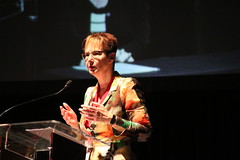 Speakers: Ashley Krenelka Chase (Stetson University College of Law), Lindsay Cronk (University of Houston), Ellen Frentzen (Boston University School of Law), and Christine Weaver-Pieh (Medina County District Library)
Speakers: Ashley Krenelka Chase (Stetson University College of Law), Lindsay Cronk (University of Houston), Ellen Frentzen (Boston University School of Law), and Christine Weaver-Pieh (Medina County District Library)
If pesky whipper-snapper seem to be moving up the ranks really fast, it’s probably because they don’t have any damn money.
Pesky Whipper-Snapper are team-oriented, which drives GenXers crazy. They are the most well educated generation so far. [Many other characteristics are described, but these two stand out to me.]
Vendor relations
Sending questions/requirements in writing to vendors has helped them take it more seriously that this person knows what they are doing. There’s a desire to develop a relationship with the individuals working for a vendor in order to have a better conduit for feedback. The communication needs to happen both ways to be productive.
Coworker relations
Take responsibility for your own actions and present how you might do something better if it fails. Know where your weaknesses are. Need to get beyond “we’ve always done it this way” — spend time regularly assessing workflows and processes to make sure it’s still necessary and appropriately distributed. Kindness and a willingness to approach the work as a team goes a long way.
Collection development
Collections is going to need to be fundamentally re-imagined, but we’re going to have to continue with the models we have as well. Don’t need to buy everything we’ve ever bought — hold off until it’s requested (i.e. standing orders). Decisions based on hard data about usage. Working with estates for endowed funds to shift the gift requirements from monographs only. Cutting the stuff nobody looks at may drive usage up for the things they do. Shifting from journal subscriptions to article purchases.
Collections budget
Previous managers held back money to make sure that all assumed needs were covered in a fiscal period – shifted to focus on the kinds of things people are asking for, and providing it when they do. Less books is not a problem if the people are finding what they need. Shifting from buying everything of a particular type to buying in targeted areas that are relevant to most of the programs supported by the library.
Missing in skill set?
Need to know more about Banner. Need to know more about faculty politics, but can’t do that until allowed in the room.
Budget priorities
Getting everything to zero by the end of the year. Don’t waste money — tracking usage — but making sure it’s spent. Staff professional development, public facing services, and the tools to do their work (i.e. Office supplies).
Identifying audiences
Stakeholders are not the same as the users (i.e. Provost/Dean, alumni, accrediting bodies). Creating personas. Identifying the shift in majors by population.
Compensating for shortfalls
Reduced sharing of materials outside the institution to keep materials there for the users. Strategic planning to identify potential cuts if they become necessary. Play it close to the vest until what is happening is actually happening, because things can change on a dime as leadership looks at big picture and shifts. Communicate budget information in a clear visual to the decision-makers, particularly to make a point of what funds are available versus what has either been spent or encumbered.
Q&A
Q: What do you do with people who don’t take responsibility?
A: Pesky Whipper-Snappers might be gun-shy about taking responsibility for things they don’t feel confident about. Use this as a teachable moment.






